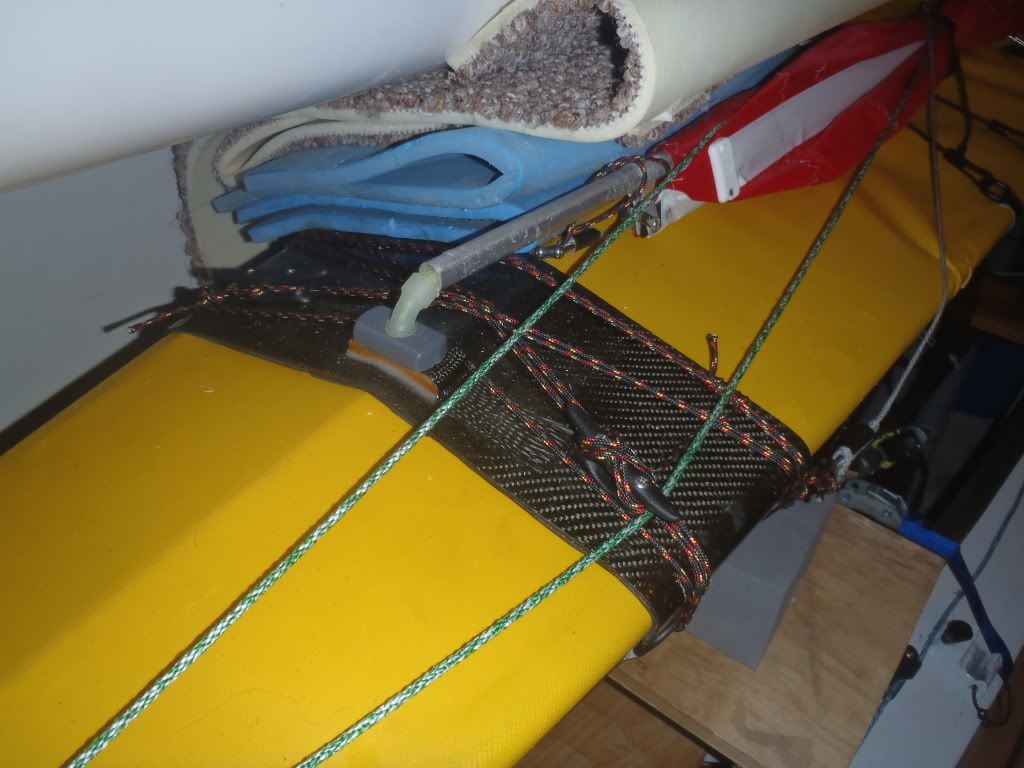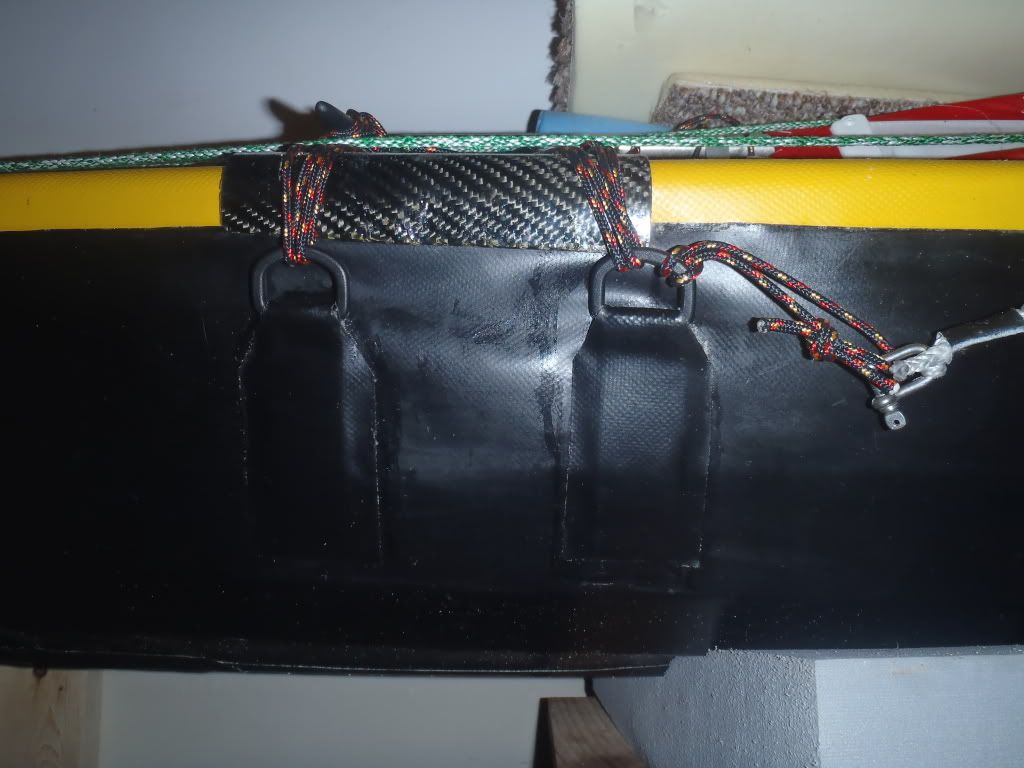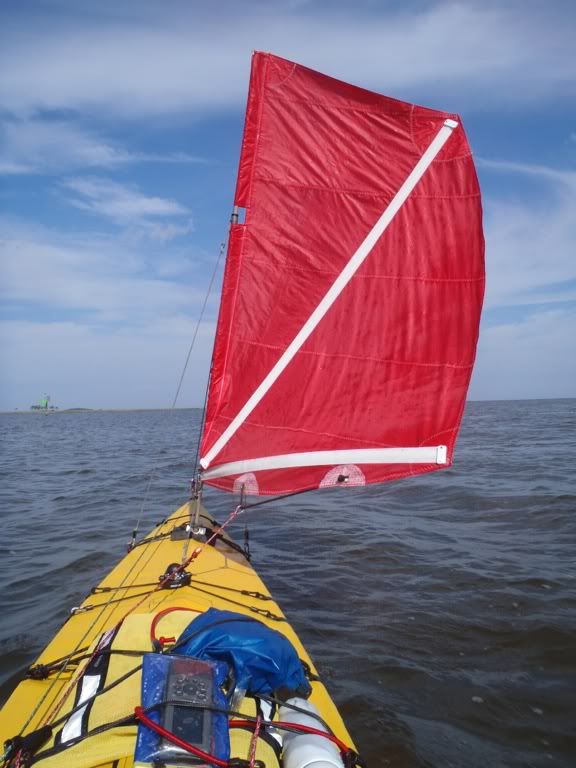The base of the mast is in compression and on a standard composite kayak, the standard approach is to reinforce this area with extra fiberglass and/or carbon fiber. Obviously, on a folding kayak with a soft fabric skin, this is not an option. In order to provide a solid base on which to mount the sail, I built a custom fiberglass and carbon fiber "plate."
 |
| Carbon fiber mast base plate |
Next was a way to keep the plate in place. First, I added some adhesive backed 1/8" minicell foam to the bottom of the plate where it contacts the gunwales and deckridge. This provides some grip, and protection for the skin. Next, I added four D-rings, one at each corner of the plate.
 |
| Additional D-rings glued to the hull skin of the kayak. |
Now that the mounting plate was complete, I needed to add the rigging. The side stays were terminated to the rear D-rings using some small shackles. This allowed me to easily remove the stays for traveling. I added one more D-ring for the mainsheet block, and also used it to connect a rear stay.
I don't have any good detailed pictures of the whole setup, but this is the closest I have.
The mainsheet (red) d-ring is just in front of the compass and the forestay (green) is connected to the bow carrying handle. The mainsheet and forestay are cleated by the cockpit using simple plastic clam cleats, which can be seen in the lower left corner of the picture above. The cleats were connected to the boat using a small loop of line through the rear mounting hole of the cleat and then looped around the deck rigging. With tension on the lines, the cleats were held straight enough that the line would not pull out.
Overall, the mounting system has worked very well for me so far, and I am very happy with it. It is lightweight, and easy to remove from the kayak. The only permanent modifications to the kayak are the four d-rings for lashing the mast base, and the d-ring for the mainsheet / rear stay.
Feel free to leave comments, questions, or suggestions!


Great work!
ReplyDeleteI am on the way to build a foldable kayak.
I am thinking about having a plywood plate consolidated under the skin during the frame construction, that will receive the mast articulation. Do you see any problem with this approach? I am not experienced in sailing
Thanks,
Gelu Botezan
Gelu,
DeleteI think that could work, but you will still need lashing points added to the hull. Actually, when I brought my folding kayak to North Carolina, I forgot to bring the carbon baseplate. I instead set the mast on top of the second frame (rigid point) and lashed it into place using the four corner points. It couldn't move forward, back, or side to side. It was functional, but raising and lowering the mast was more difficult and not a secure as with the external plate system.
How would you plan to attach the flexible mast base to your plywood plate?
Thanks for the answer,
ReplyDeleteI think the best way would be to have the mast attachetd to a small plate(a bit bigger than the one delivered with the flexible joint). This plate would be attached to the plate under the deck skin, through the skin.
While the plywood plate will be permanently there, by assembling the kayak I will need each time to seal the holes punched into the skin. This will happen by using some screws that at the upper part ends with a nut in order to receive the mast base made as described above.
Well this is actually a thought that came into my mind while studying your sistem.
I know I will need some lashing points in order to get the mast upright, and lowe it. This will not be a problem using PVC truck tarp.
I use since "86 a Pouch RZ 85 (it is a double)and in the last time, think of making a foldable single ( an macmilan or another greenlander)
Thanks again,
Gelu
Hi
ReplyDeleteWhat kind of glue did you use to glue to tabs onto your folding kayak hull? What material is your hull made from?
I have a feathercraft with a urethane hull and I am not sure what glue product to use. Feathercraft say only use Aquaseal, but I dont know if that is strong enough.
Sandy,
DeleteMy boat is made with PVC fabric which is glued with HH-66 vinyl cement. HH-66 is specifically designed for use with PVC and I am not sure if it is compatible with urethane. I did a little browsing and found some information on the Alpacka Raft website. They recommended a product from NRS: http://www.nrsweb.com/shop/product.asp?pfid=1901&deptid=1032
May be worth a try...
Good luck!
Ben
In case the link doesn't work, the glue is called "Clifton Urethane Adhesive"
Deletesportsman boats Saint Petersburg FL I am impressed. I don't think Ive met anyone who knows as much about this subject as you do. You are truly well informed and very intelligent. You wrote something that people could understand and made the subject intriguing for everyone. Really, great blog you have got here.
ReplyDelete